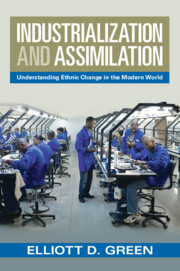Book contents
- Industrialization and Assimilation
- Industrialization and Assimilation
- Copyright page
- Dedication
- Epigraph
- Contents
- Figures
- Maps
- Tables
- Acknowledgements
- 1 Introduction
- 2 Understanding Ethnicity and Industrialization
- 3 Industrialization and Assimilation in Historical Perspective
- 4 Cross-National Evidence
- 5 Industrialization and Assimilation in Mid-twentieth-Century Turkey
- 6 Cases of Non-industrialization in Africa
- 7 ‘Cattle without Legs’
- 8 Ethnic Change among Native Americans in the United States
- 9 Ethnic Change among the Māori in New Zealand
- 10 Conclusion
- Appendix Country-Level Data Used in Chapter 4
- Bibliography
- Index
7 - ‘Cattle without Legs’
Structural Transformation in Botswana
Published online by Cambridge University Press: 18 November 2022
- Industrialization and Assimilation
- Industrialization and Assimilation
- Copyright page
- Dedication
- Epigraph
- Contents
- Figures
- Maps
- Tables
- Acknowledgements
- 1 Introduction
- 2 Understanding Ethnicity and Industrialization
- 3 Industrialization and Assimilation in Historical Perspective
- 4 Cross-National Evidence
- 5 Industrialization and Assimilation in Mid-twentieth-Century Turkey
- 6 Cases of Non-industrialization in Africa
- 7 ‘Cattle without Legs’
- 8 Ethnic Change among Native Americans in the United States
- 9 Ethnic Change among the Māori in New Zealand
- 10 Conclusion
- Appendix Country-Level Data Used in Chapter 4
- Bibliography
- Index
Summary
In Chapter 7 I move onto the case study of Botswana, which in contrast to Somalia and Uganda has experienced structural transformation due in large part to its diamond industry. Industrialization in Botswana has led to a sectoral shift out of agriculture as workers have left rural areas to move to cities and join the modern workforce, thereby leading to a decline in the relative value of rural land. I employ both qualitative and quantitative evidence to show that ethnic fractionalization has declined in Botswana since the mid-twentieth-century and examine parliamentary debates around ethnic identity. Moreover, I show that this shift has happened not because of but largely despite efforts of the Botswanan state, which has both discouraged rural-urban migration and failed to alleviate institutional ethnic inequalities that persist to the present day. Finally, I consider alternative explanations for ethnic homogenization in Botswana and find them all wanting.
Keywords
- Type
- Chapter
- Information
- Industrialization and AssimilationUnderstanding Ethnic Change in the Modern World, pp. 136 - 160Publisher: Cambridge University PressPrint publication year: 2022

